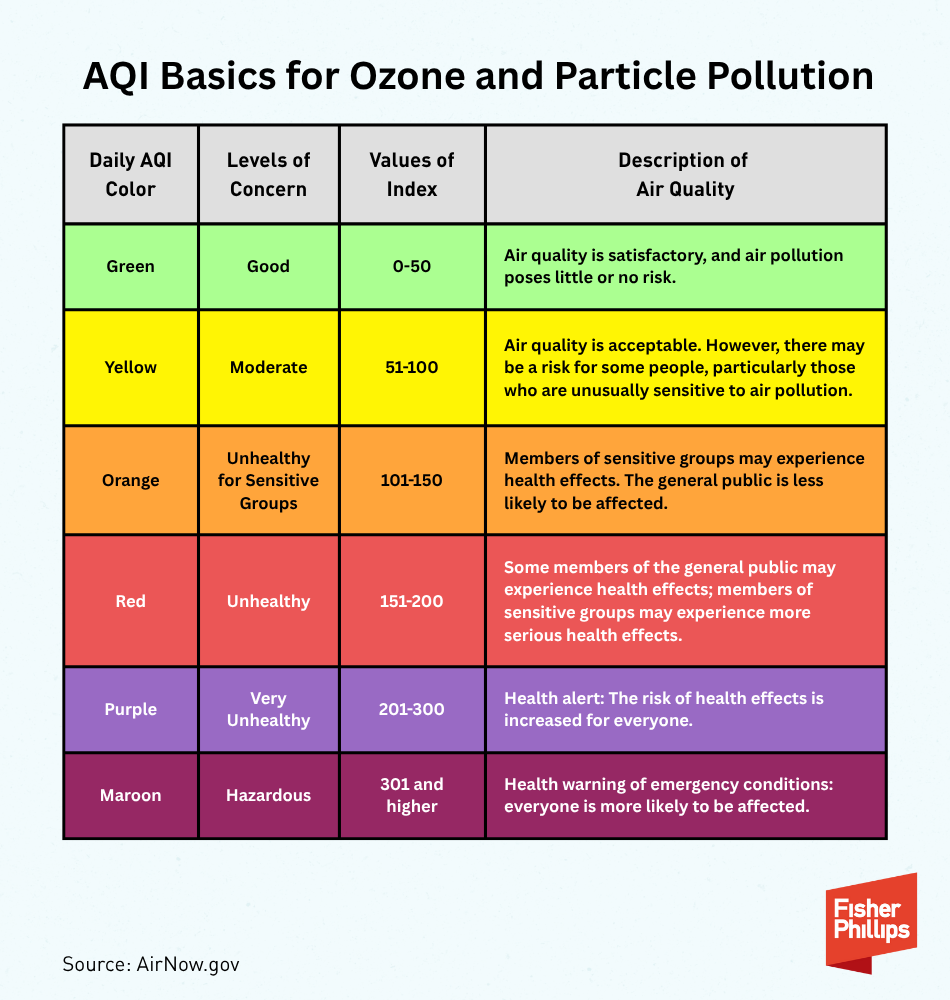4 Ways Nevada Employers Can Prepare for Wildfire Smoke Regulations
Insights
7.01.25
Certain employers in Nevada will soon need to monitor air quality and reduce employees’ exposure to wildfire smoke under a new state law that Governor Lombardo approved on June 10. Here’s what Nevada employers need to know about the new law – including key portions that take effect in January – and four ways you can prepare for pending regulations aimed at protecting employees who work outdoors.
|
Snapshot
1. obtaining the proper air quality monitoring tools; 2. ensuring outdoor workers have adequate personal protective equipment (PPE); 3. establishing a communication system with employees for issues caused by exposure to poor air quality from wildfire smoke; and 4. creating a training program for employees who may be exposed to poor air quality caused by wildfire smoke. |
Why Did Nevada Implement New Air Quality Regulations?
The law was prompted by research into health hazards caused by the complex composition of wildfire smoke and the potentially toxic compounds outdoor workers may be exposed to from the smoke.
Symptoms and adverse health effects from wildfire smoke exposure vary but some known or suspected health effects include eye irritation, sore throat, wheezing, coughing, asthma, chronic obstructive pulmonary disease (COPD) exacerbations, bronchitis, pneumonia, and adverse birth and cardiovascular (heart and blood vessel) outcomes.
Nevada joins California, Oregon, and Washington as recent states to adopt permanent rules to regulate on-the-job wildfire smoke exposure.
Who Will Be Covered?
The new regulations apply to private businesses and both state and local government employers with more than 10 employees, though certain provisions will apply only to employers with employees performing “critical tasks outdoors.”
Are There Any Exceptions?
Employers with 10 or fewer employees will not need to comply with these impending regulations. Additionally, employers of any size with employees who work in the operation of a mine, operate commercial trucks, or provide emergency services (such as police, firefighters, and EMTs) will not be required to comply with these regulations.
What Actions Will Covered Employers Need to Take?
Employers will need to take certain steps designed to protect workers from health hazards associated with exposure to wildfire smoke. These measures aim to identify, monitor, prevent, and respond to related hazardous working conditions. Here’s a breakdown of the measures the regulations are expected to require:
Monitor Poor Air Quality Caused by Wildfire Smoke:
Employers will be expected to monitor the air quality index (AQI) for PM2.5 particle pollution (involving fine inhalable particles with a diameter of 2.5 micrometers or less) and take action when the AQI reaches 150 or greater. The AQI is composed of six colored categories, each representing a different level of health concern.
Available tools for employers to monitor AQI include:
- the US Environmental Protection Agency’s current AQI monitor and Fire and Smoke Map;
- the AirNow Mobile App;
- a subscription to EnviroFlash for emails about daily air quality forecasts; and
- direct reading instruments, such as:
- PM 2.5 sensors;
- multipollutant sensor systems; and
- vehicle add-on mobile monitoring systems.
Reduce Exposure to Poor Air Quality from Wildfire Smoke
Covered employers will be required to reduce their employees’ exposure to poor air quality caused by wildfire smoke when the AQI is 150 or more (red, purple, and maroon categories). At these AQI levels, employers must prohibit employees from performing “critical tasks outdoors.”
The Administrator of Nevada’s Division of Industrial Relations may develop written guidance for complying with the impending regulations, which may account for working conditions in rural and remote locations.
Establish a Communication System
Every employer will be required to establish a communication system to inform employees who work outdoors of dangerous AQI levels and to receive information from employees about related symptoms they are experiencing.
The communication system should be capable of alerting employees:
- when they are exposed to an AQI of 150 or more during their shift; and
- about the protective controls available to them to reduce exposure to poor air quality.
The communication system should also allow employees to inform their employer:
- when they are exposed to an AQI of 150 or more in the workplace; and
- if they are experiencing any symptoms related to the exposure, such as difficulty breathing or chest pain.
The system should be easy for employees to understand and take language barriers and any employee limitations on communication into consideration.
Implement a Training Program for Employees Who Work Outdoors
The Administrator of Nevada’s Division of Industrial Relations was directed to ensure the training:
- is provided in a manner that is understandable to the employee;
- describes employer requirements; and
- explains the risks when employees do not use PPE while working outdoors and are exposed to poor air quality from wildfire smoke.
4 Things You Can Do to Prepare for the New Law
1. Download the EPA AirNow Mobile App. Get familiar with the color-coded AQI categories, AQI levels in the areas of Nevada where your employees work outdoors, and the fire and smoke maps.
2. Identify PPE that can protect against poor air quality. Ensure outdoor workers have access to gloves, goggles, protective footwear, and other protective clothing and equipment, such as particulate filtering respirators labeled N95, N99, N100, R95, P95, P99, or P100.
3. Create a communication system for air quality issues. Communications should be clear and in a language your employees understand. Use email, text alerts, signage, or toolbox talks to ensure everyone is informed of current air quality levels and the location of PPE and respiratory protection.
4. Build a training program for employees who work outdoors. Training can ensure your communication system operates effectively. Your employees who work outdoors should be able to identify symptoms related to poor air quality exposure so they can properly report issues. They should also understand the importance of using PPE to prevent or mitigate symptoms.
Conclusion
If you have any questions, contact your Fisher Phillips attorney, the authors of this insight, any member of our Workplace Safety and Catastrophe Management Practice Group, or any attorney in our Las Vegas office for guidance. Make sure you are subscribed to Fisher Phillips’ Insight System to get the most up-to-date information on workplace safety issues.
Related People
-
- Brandon Born
- Associate
-
- Todd B. Logsdon
- Partner
-
- Mark J. Ricciardi
- Regional Managing Partner



